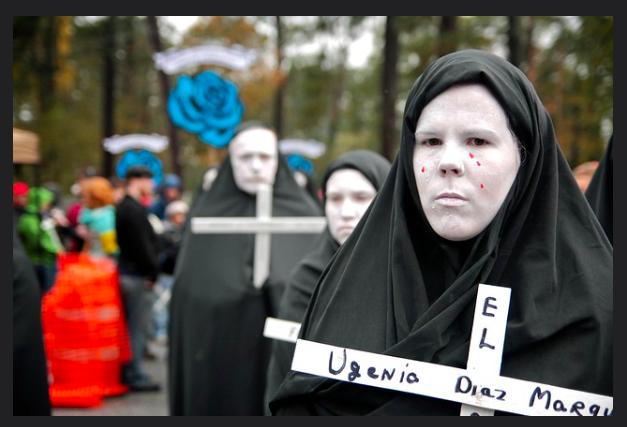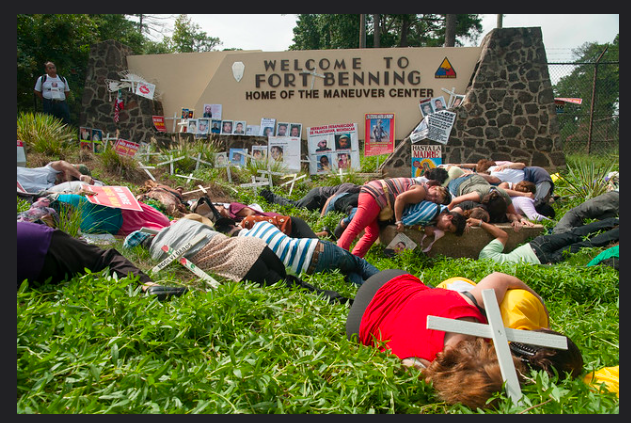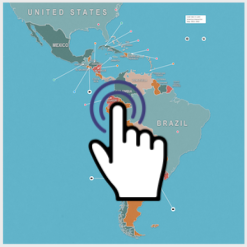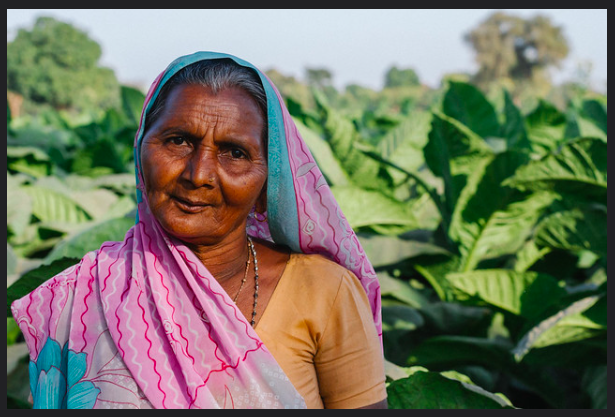4.4 Mixed Impacts of Foreign Assistance, Humanitarian Aid, and Development
The combined efforts of foreign assistance, humanitarian aid, and development since the 1960s is immense. Since the 1970s U.S. assistance has helped cut in half the number of preventable deaths of children under five, people living in poverty, and the number of children and adolescents unable to attend school (Interaction n.d). The average life span increased 24 years between 1960 and 2017 (Norris 2021). Extensive campaigns against cholera, smallpox, malaria, and polio have been very successful, with polio nearly eradicated and smallpox abolished entirely. Campaigns have also been successful that shifted economic circumstances to allow millions of girls access to a basic education, and offered family planning programs that give women and men a chance to choose smaller families.
In 2020, the United States sent about $33 billion on foreign assistance to other countries (a considerable amount, but less than one percent of the federal budget). The Organisation for Economic Co-operation and Development states that total global aid (humanitarian and foreign assistance) since 1960 has been about $4.7 trillion, calculated as a combination of cash, in kind and personnel support and taking account of inflation (Barder 2014).
Take a brief look at this interactive map of the USAID (Figure 4.9) that documents trends in US foreign assistance. Set the year to 1946, press play, and watch where dollars were obligated to foreign countries through the decades until today. What overall changes do you notice? What connections can you make between political, historical, and environmental events that might account for the funding priorities for some of those years?

Figure 4.9. USAID’s interactive map of US foreign assistance (linked above) provides a dynamic visualization of trends in US foreign assistance.
The World 101 project of the Council on Foreign Relations introduces some key thoughts on the influence and effectiveness of foreign aid.
4.4.0.1 Does foreign aid work?There is no simple answer to that question. Some experts note a lack of accountability for programs and places that receive aid to demonstrate effectiveness in achieving its goals; the accountability issue fuels criticisms that foreign aid is a waste of money. And in some cases, it’s difficult to determine whether foreign aid has achieved its goals: when, for example, the long-term goals include such things as sustainable development or a more peaceful world, measuring outcomes is difficult, especially in the short term. Sometimes the effects of foreign aid can be more easily identified. As of 2020, the President’s Emergency Plan for AIDS Relief (PEPFAR) has delivered care to more than 17 million people (including 6.7 million children) and provided training for 290,000 health workers in sub-Saharan Africa. (When the program launched in 2004, only fifty thousand people in Africa had access to any antiretroviral treatment.) Projects like PEPFAR that distribute humanitarian and development assistance demonstrably save lives and promote long lasting development. But other programs are more of a mixed bag. Despite having received more than $100 billion in U.S. aid since 2002, several USAID projects in Afghanistan remain unfinished, with corruption a pressing issue. When misused, foreign aid can perpetuate graft, reward mismanagement, and prop up authoritarians. The bottom line is that foreign aid can help but it can also be wasteful or even harmful. What is true is that U.S. foreign aid has a far reach: economic and development aid that helped rebuild Europe after World War II, humanitarian aid in Africa, and more recently military and development aid to Afghanistan. Only a few places in the world haven’t felt the influence of U.S. aid in some way. |
4.4.1 Critical Responses to Foreign Assistance and Development
As a global community what did we learn from these sixty decades of foreign assistance and development action? We’ve learned how to respond to conflicts related to war, natural disasters, and famine. We’ve also learned how to measure, monitor, and improve severe levels of poverty, lack of education, and severe global health emergencies such as pandemics. We’ve also developed a rapid and encompassing global emergency response system.
Alongside these developments, in the mid 1990s, we began to see a watershed of scientific and grassroots critique of foreign assistance and development applied by many large-scale organizations. Today, some see that these models are responsible for soaring international and local financial indebtedness, exacerbation of human rights crises, depleted soils, threats to native seeds and biodiversity, erosion of knowledge and skills of local people, and loss of local cultural expression.
4.4.1.1 National Interests and Support to Foreign Nations
Key to understanding globalization and inequality is the fact that often national funds and the work of government sponsored organizations are offered with the added purpose of serving the interests of their home nation. These interests might be straightforward. For example, nations might donate to poor countries to reduce possible negative spill-overs of issues from poor nations. Avoiding infectious disease, environmental degradation, violence and human trafficking, are some examples.
Other interests may be more complicated. Governments of richer countries also have an interest in opening new trade markets, and keeping current ones healthy. If they are able to donate to struggling nations to help them stay free of crisis and more prosperous, that means there are more people to buy their goods.
Some humanitarian and development professionals are comfortable with these kinds of “win-win” approaches that aim to serve both the donor and recipient nations. Others point to the fact that when funds are vested to struggling countries for the interests of donor nations, often more poverty and violence is created.
Author John Norris lists some examples of US assistance that has proven to create more problems than help. Support to Vietnam in the 1960s and 70s, to Egypt in the 1980s and 1990s, and support to Afghanistan and Iraq in the wake of September 11 have yielded disappointing and detrimental results. He adds,“Each of these settings involved high-profile national security priorities, where resources and manpower were almost unlimited but there was very little willingness to question how, or even if, development could work under such conditions.” (Norris 2021).
Another more current example is with the US food aid program, an initiative of the U.S. Agency for International Development (USAID). The program has required that food be supplied to poor nations from US farms and transported on US ships. Some see this arrangement as a “win-win” as the US farmers receive income for the food they provide. However, with this system the program feeds far fewer people than it could if food was delivered from a closer region. It is also a considerably ineffective way of delivering aid. In 2018 members of congress introduced changes to this system that would give the USAID the flexibility to use cash, vouchers, or locally purchased food when one of those would be faster and more effective in helping hungry people in need (Casey 2021).
There’s a long history of controversy around the importation of food to poor nations when it is fueled by powerful corporations. In the 1970s the Swiss food company Nestlé faced international criticism for its marketing practices. Protestors claimed Nestlé’s promotion of their baby formula was causing infant illness and death in poor communities as it encouraged mothers to abandon breastfeeding.
Controversy with Nestlé has continued since the 1970s (INFACT Clearinghouse 1978). In 2011, nineteen NGOs based in Laos organized a boycott of Nestlé criticizing the company for failing to translate labeling and health information into local languages and for offering incentives to doctors and nurses to promote the use of infant formula (Aid agencies in Laos refuse to apply for Nestle cash 2011).
Watch this 3:56-minute video produced by the New York Times, “How Junk Food is Transforming Brazil” that describes how the Nestlé controversy shows up in Brazil (Figure 4.10). As you watch, consider that today, Nestlé is the largest publicly held food company in the world. It also provides donations to development organizations such as the World Health Organization Foundation (Igoe 2021) and is collaborating with the Swiss government on development efforts (Franklin 2020). What potential concerns and consequences can you see with powerful food companies working with governmental and international aid agencies?
Figure 4.10. How Junk Food is Transforming Brazil | Times Documentary [YouTube Video]
4.4.1.2 Militarism, human rights and regime change
Some international military interventions and international organizations are controversial in the context of human rights, assistance, and development. An organization of the international military system that has come under great scrutiny is the Western Hemisphere Institute for Security Cooperation (WHINSEC).
Formerly called the School of Americas, WHINSEC is a United States Department of Defense school. Its current website reads that since 2001 it has “…championed human rights and democracy by developing a new generation of ethical leaders to confront the uncertain and complex security challenges of the Western Hemisphere” (WHINSEC).
Since the school’s initial opening as School of Americas, the organization has trained over 64,000 Latin American soldiers in counterinsurgency techniques, sniper tactics, commando and psychological warfare, military intelligence and interrogation tactics (Knapke 2019).
A number of graduates of the SOA and WHINSEC have been accused and sentenced for human rights violations, genocide, crimes against humanity and other criminal activity in their home countries (School of the Americas Watch 2007). Further criticism is related to training manuals used at the school, provided by the U.S. military, that referenced execution, torture, blackmail, false imprisonment and other forms of coercion (Priest 1996). Other manual information referred to “potential insurgents” as “religious workers, labor organizers, student groups, and others in sympathy with the cause of the poor.” (Quigley 2005) which is a violation of international humanitarian law.
The School of the Americas Watch (SOA Watch) is an organization dedicated to closing the school and keeps track of officers known to have committed atrocities after graduating. They have documented atrocities including the assassination of Catholic bishops, labor leaders, women and children, priests, nuns, and the massacres of entire communities. SOA Watch has organized protests against WHINSEC (Figure 4.11) that include direct action at the school itself (Figure 4.12).


Figure 4.11. A protestor, dressed for a staged funeral procession that commemorates civilian victims of soldiers trained by WHINSEC.
Figure 4.12. A group of protestors staging civilian victims of soldiers trained by WHINSEC. image.
WHINSEC is not an income-generating school. Over recent years it has received just under $10 million (approved by Congress), per year to run (Washington Office on Latin America’s Defense Oversight Program). The training of Latin American soldiers is important to members of the US Department of Defense and some lawmakers because it is seen as critical to U.S. national security. In 2007 former U.S Representative Phil Gingrey explained:
(The school)…may be the only medium we ever have to engage the future military and political leaders of these Latin American countries, who are America’s closest neighbors… If we were not to engage with these nations … the void created would be filled by countries with different values than our own regarding democracy and human rights, countries such as Venezuela and China, whose influence in the region is growing (Grills 2011).
Modern US national security interests related to countries with “different values than our own” goes back to the Cold War, the ideological and geopolitical struggle for global influence between Russia (then the Soviet Union) and the US. The direct cold war between the two countries began shortly after the Second World War. The Soviet Union supported the expansion of communist governments around the globe, and the United States supported anti-communist regimes. This conflict has manifested in the US supporting a number of coups and other military interventions. In the case of WHINSEC, Panama’s former president, Jorge Illueca described the school as the “biggest base for destabilization in Latin America.” (Chalmers 2004).
Concern about communist influence has waned considerably, but it still influences some US policymakers today. After the September 11, 2001 terrorist attacks, terrorism eclipsed communism as the major threat considered when prioritizing aid.
Take a few minutes to browse this Cold War in Latin America Interactive Map, created by David Olson, for a snapshot of those interventions between 1953 and 1992 (Figure 4.13).

Figure 4.13. David Olson’s interactive map (linked above) provides dynamic snapshots of US military interventions in Latin America between 1953 and 1992.
What is your first impression of the map? What do you notice? What questions immediately come to mind?
4.4.2 The Green Revolution Program
Perhaps the best case study to examine the critique of large-scale international development projects is the Green Revolution program. Beginning in the 1960s the Green Revolution was an initiative to increase the global food supply and reduce world hunger by the use of chemicals and engineered crop varieties. Programs were supported by scientists, development professionals, and Western leaders concerned that such hunger would make countries vulnerable to communism.
The strategy of the Green Revolution was to introduce irrigation, mechanization, fertilizers, pesticides, and genetically modified, high-yield varieties of food grain to increase production in poor countries. Rice and wheat were the forerunners in this experiment. These crops replaced smaller subsistence farming, especially India, Mexico, Pakistan and the Philippines.
4.4.2.1 Dependence on overseas solutions
Production did increase significantly. The production of maize, wheat and rice almost doubled between the 60s and 90s. Fewer people experienced hunger (Conway 1998).
However, in order to achieve these high yields farmers were required to apply imported varieties of pesticides and fertilizers, give additional nutrients to plants, and develop more efficient irrigation and crop management techniques. These methods created or increased poor people’s dependence on technological solutions created in the faraway laboratories and factories in the United States and other industrialized nations.
For example, the Indus Valley, along the border with India and Pakistan became the breadbasket for wheat in India. However, the new high-yielding variety crops were reliant on water fertilizers and pesticides. As in many other parts of the world only farmers with more capital (and larger plots of land) were able to gain access to the money needed to buy the fertilizer, buy the pesticides or herbicides, and obtain water access. Therefore, often instead of improving the lives of small-crop farmers these programs displaced them from their land. As time went on, those fertilizers and pesticides also polluted the soil and water in the area (Ahmad, Zubeida Manzoor et. al. 1973).
4.4.2.2 Dependence on foreign loans
The Green Revolution funding was in part provided by the philanthropist organizations, the Rockefeller Foundation and the Ford Foundation, as well as the US government (Patel 2013). In many cases funding that governments needed to implement Green Revolution farming methods came from organizations like the World Bank. Those loans required that countries provide local farmers access to products from the donor nations. Critics argue this benefitted the donors more than the recipients and put poor farmers at risk when they become dependent on new technologies and then fail to earn enough with their crops to pay rising prices for seeds, fertilizers, and pesticides.
Farmers in developing nations (Figure 4.14) have been encouraged with generous loans to invest in expensive capital equipment they cannot afford to purchase or replace machinery parts when the loans disappear.
4.4.2.3 Crisis in India

Figure 4.14. Woman Tobacco Farmer, India
An epidemic of suicides of farmers in India began in the 1970s and still exits today. Many attribute these deaths to farmers’ inability to escape the cycle of debt created by their involvement in high-tech agriculture. While it is difficult to track reasons for suicide, and suicide is often prompted by more than one life circumstance, some data collected by the Institute for Social and Economic Change do point to debt and high-tech agriculture as a main cause.
The National Crime Records Bureau of India reported that a total of 296,438 Indian farmers committed suicide between 1995 and 2013 (Parvathamma 2016). The survey of 528 farming families conducted by the Institute for Social and Economic Change found that while unmet expectations of more credit, and failure to get better crop prices contributed to many suicides, farm indebtedness was considered as the major triggering factor in most of the cases (Manjunatha and Ramappa 2017).
As colonialism remains in the form of neocolonialism, the effects of the Green Revolution remain in the form of lingering multinational corporate control over production processes and resources needed for this kind of farming. In the 1990s this control became more pronounced as patent protections began to be granted to private companies that develop and market genetically modified (GM) seeds. For example, the company Monsanto developed GM corn and soy varieties which produce higher yields, but they require the use of Monsanto’s herbicide, forcing farmers to be dependent upon Monsanto products. With this change, the Green Revolution became a “Gene Revolution.” (Food First n.d.).
4.4.3 Going Deeper
- For more information on The School of Americas/Western Hemisphere Institute for Security Cooperation (WHINSEC) watch the two videos,”School of Assassins 1/2” and “School of Assassins 2/2”
- For more information on the Latin American Cold War, watch this 6:29-minute video,” Dictators and Civil Wars: The Cold War in Latin America”, and see other resources by retroreport.org. Find a transcript of the video here.
4.4.4 Licenses and Attributions for Mixed Impacts of Foreign Assistance, Humanitarian Aid and Development
“Mixed Impacts of Foreign Assistance, Humanitarian Aid, and Development” by Aimee Krouskop is licensed under CC BY 4.0
Figure 4.9 Screenshot of USAID’s interactive map of US foreign assistance is adapted with “Interactive icon” by Thomas Shafee licensed CC BY ”
“Does Foreign Aid Work?” by World 101/Council on Foreign Relations, A Brief History of U.S. Foreign Aid is licensed under CC BY-NC-ND 4.0.
Figure 4.10 “How Big Business Got Brazil Hooked on Junk Food
Figure 4.11. A protestor, dressed for a staged funeral procession that commemorates civilian victims of soldiers trained by WHINSEC is authored by Steve McFarland and published on Flickr under the CC BY-NC 2.0 license.
Figure 4.12. A group of protestors staging civilian victims of soldiers trained by WHINSEC is published on Flickr by Caravan 4 Peace under the CC by 2.0 license.
Figure 4.13. Screenshot of David Olson’s “Cold War in Latin America-Interactive Map” is adapted with “Interactive icon” by Thomas Shafee licensed CC BY
Figure 4.14. Woman Tobacco Farmer, India India is published at Flickr and licensed under BY-NC-ND 2.0
